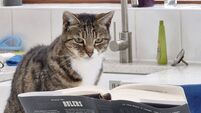Happy ending to dolphin tale
According to the Irish Whale and Dolphin Group (IWDG), this was the first successful rescue of a dolphin in Ireland and there’s an unexpected bonus; the patient was pregnant during her ordeal and has since given birth.
For reasons unknown, dolphins and whales become stranded on beaches. Victims can’t survive for long out of water. Lying on a beach, a cetacean’s internal organs may be crushed under its enormous weight, causing internal injuries. Without the sea’s cooling water around it, the body rapidly overheats and dehydration sets in.
Most whales die before they can be helped, but some are re-floated and coaxed back out to sea. Not much is known, however, about their subsequent fate. Are re-floated whales affected by injuries shock or stress from their ordeal? Would a pregnant dolphin lose her baby? The Shannon estuary is famous for its bottle-nosed dolphins. They have become a major tourist attraction; boats from Kilrush and Carrigaholt take visitors out to see them.
Last April, three bottle-noseds swam up the River Ratty as far as the castle that bears its name. Tourists and sight-seers flocked to see them and they featured on television news bulletins. Despite fears that the dare-devils would become stranded, they made their way safely back to the Shannon. Beaching is rare among inshore species. The bottle-nosed, despite being very common, ranks eleventh in the league table for strandings among the 23 cetaceans on the Irish list.
The Shannon dolphins know how to avoid trouble but there’s an occasional mishap. On Jun 1, 2012, one of them misjudged a fast receding tide and became stranded at Béal, on the Kerry side of the estuary. Members of the Shannon Dolphin and Wildlife Foundation were quickly on the scene. The victim, a mature female, was 3.4m long. There was no sign of injury and she didn’t seem too distressed. Her temperature was rising rapidly, however, so it was imperative to get her back into the water quickly.
A tractor with a large transport box was used to lift and move her. A re-floated dolphin will be disorientated initially and her muscles may be stiff, so the patient was restrained in the water for a while to allow her acclimatise. When released, she swam away. It wasn’t known at the time that she was pregnant.
Bottle-nosed dolphins have a large dorsal fin which protrudes from the water. Like a human fingerprint, a dolphin’s fin can disclose its owner’s identity. Researchers have been photographing fins in the Shannon estuary, building up life histories for individual animals.
On Jun 27, less than a month after her release, the Béal dolphin was seen from a tourist boat. The sighting was confirmed on several subsequent occasions; contrary to expectations, she had survived. It’s the first time that a stranded bottle-nosed dolphin has been successfully rehabilitated in Ireland.
Then there was another surprise; on Sept 8 the Béal dolphin had a newborn calf with her. They were in a group of mothers with babies. Bottle-noses are social animals. A female seen with a calf is not necessarily its mother; the older animal could be an auntie or another relative.
In May and Jun this year the calf, now much larger, was seen with her minder again. The two were photographed on June 5 and June 6. Whenever the Béal dolphin was seen, the calf was present, removing any doubt that the baby is hers. Bottle-nosed dolphins, in this part of the world, tend to mate between May and September. The gestation period is 12 to 13 months. The Béal dolphin, therefore, was about nine months pregnant when she became stranded.
Well done Breda, Conor and Finbarr Breen, Mike Hennessy, Mark O’Brien and the others who carried out the rescue.













